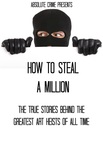How to Steal a Million: The True Stories Behind the Greatest Art Heists of All Time

If movies teach us anything, it's that art theft involves glitz, glamour, and above all else, sophistication. Movies lie! In reality, art robberies often involve people who don't know anything about the art they are stealing.
This book looks at fifteen of the most fascinating and notorious art robberies. Prepared to be amazed at how shockingly idiotic some of them were!
This book looks at fifteen of the most fascinating and notorious art robberies. Prepared to be amazed at how shockingly idiotic some of them were!
Buy Now!
How to Steal a Million PDF and ePub |
Excerpt
Introduction
If movies teach us anything, it's that art theft involves glitz, glamour, and above all else, sophistication. Movies lie! In reality, art robberies often involve people who don't know anything about the art they are stealing.
This book looks at fifteen of the most fascinating and notorious art robberies. Prepared to be amazed at how shockingly idiotic some of them were!
They Stole Norway’s Most Valuable Painting: The Low-tech Theft of The Scream
Introduction
In 1994 it took just 50 seconds for two men to steal a Norwegian national treasure worth an estimated $72 million. The treasure was The Scream by Edvard Munch, one of the world’s most recognized paintings.
It was taken out of Oslo’s National Gallery by two thieves whose equipment consisted of a hot car, a ladder, a hammer, and some wire cutter. That’s right—the tools used to steal a $72 million painting were probably purchased at the local hardware store for less than $50.
The theft became a national embarrassment to Norway, a country not noted for lawlessness or crime, because it occurred on February 12, 1994—the day the Winter Olympics opened in Lillehammer. Most of Norway’s police and security personnel were busy protecting the opening ceremony, giving the thieves a clear shot.
The Low-Tech Thieves Who Left Their Card
The theft of The Scream unfolded more like a household burglary than a sophisticated crime. All the culprits did was use a ladder to climb up to a window and a hammer to smash the window open. They then used the wire cutter to cut the wires that held the painting in place.
To add insult to injury the crooks left a postcard that said: “A thousand thanks for the poor security.” They then made their escape in a stolen car like any other gang of small-time hoodlums.
The crooks were so incompetent that they were actually caught on surveillance video during the theft. The fact that the burglars failed to disable the security camera indicates how amateur they really were.
Scotland Yard to the Rescue
The Norwegian police were helpless in the face of such amateur thievery. They couldn’t even catch fairly amateur crooks whose pictures were on camera. Fortunately, one of the world’s top police agencies came to the rescue by sending in some of its best detectives.
Scotland Yard’s Art and Antiques Unit sent one of its top investigators, Charley Hill, to Norway. Hill met with Norwegian cops, then went undercover as Christopher Charles Roberts, a “buyer” for the Getty Museum in Los Angeles. The Yard, or perhaps one of Britain’s famed intelligence agencies such as MI-5 or MI-6, even provided Hill with fake ID to verify his identity.
“Christopher Roberts” then put out the word to Norway’s underworld that he was willing to pay a lot of cash for The Scream. It didn’t take long for the thieves to contact him. Some media reports indicate that Scotland Yard’s sources may have already been in contact with somebody trying to sell The Scream before Hill came to Norway.
The crooks arranged a meeting at a hotel in Asgardstrand north of Oslo. They came and brought The Scream. Hill met them and brought the Norwegian police, who recovered the national treasure and arrested the culprits. The painting, unlike Norwegian national pride, suffered only extremely minor damage.
A Media Circus and Other Bizarre Happenings
Part of the reason why Hill was able to operate so smoothly was the media circus surrounding the theft. Norway’s government received two very weird ransom requests. The first came from an anti-abortion group, which demanded that one of its propaganda films be shown on national TV. The second was a false ransom demand for $1 million. Both attempts at ransom were ignored because they didn’t come from the actual thieves.
The carnival atmosphere continued at the thieves’ trial in January 1996. The gang’s leader, Paal Enger, reportedly broke down on the stand and started acting bizarrely at his conviction. Despite his weird behavior, Enger was an experienced art thief, who was very familiar with Edvard Munch’s work. In 1988 Enger was sentenced to four years in prison for stealing another Munch painting, The Vampire. Enger was sentenced to six years in prison. His accomplice, William Asheim, was sentenced to four years in prison.
One aspect of the investigation that was not detected by the media at the time was the true nature of Scotland Yard’s involvement. No mention was made of Charley Hill’s undercover work or his sting operation. Instead, newspapers merely reported that Art Squad commander John Butler was working closely with Norwegian detectives. Some reports also mentioned a “prominent art dealer,” probably a reference to Hill’s alter ego, “Christopher Roberts.”
How Art Thieves Get Caught
Like many other criminals, art thieves often get caught by their greed. Stolen art, especially well-known works like The Scream, are often very difficult to fence. Only well-organized criminal cartels can move them. The only market for such work is usually in countries like Japan and Belgium, where the law gives legal ownership to the buyers of stolen goods. Getting the goods to such markets can be difficult.
When crooks get word that somebody is offering big cash for stolen art, they often take the bait. They are willing to take the risk of selling the work at pennies on the dollar to a mysterious figure that might be an undercover cop because the market for hot art is so limited.
The Scream Is Still a Target of Thieves
The Scream was returned to its home in Oslo’s National Gallery, where in 2004 it was the target of yet another attempt at theft. This time the beefed up security installed after the 1994 crime worked and apparently thwarted the crime. Enger, Asheim, and their accomplices served their time in Norway’s cushy prison system and returned to private life.
Charley Hill retired from the Yard and went into the private sector as a consultant and expert on art theft. He also wrote a book on the subject and his exploits, called The Rescue Artist. Hill is now very much in demand as a consultant to museums and the media because he is the world’s foremost expert on art theft. In his career, Hill recovered several stolen masterpieces, including Vermeer’s Lady Writing a Letter with her Maid and The Scream.
Bibliography
Associated Press. "World News Briefs: 4 Norweigians Guilty in Theft of "The Scream"." 8 January 1996. nytimes.com. NY Times News Brief. 10 February 2013.
Bellos, Alex. "From the archive 9 May 1994: Edvard Munch's stolen Scream Recovered in undercover sting." 9 May 2012. guardian.co.uk. Guardian newspaper article. 10 February 2013.
Edgers, Geoff. "Who Steals Art?" 14 March 2010. boston.com. Boston Globe Newspaper Article. 6 February 2013.
Franz, Paris. "The Theft of the Scream." 1 April 2012. parisfranz.com. Blog Entry. 10 February 2013.
The History Channel. "This Day in History the Scream Recovered." n.d. history.com. News Article in Internet Archive. 10 February 2013.
If movies teach us anything, it's that art theft involves glitz, glamour, and above all else, sophistication. Movies lie! In reality, art robberies often involve people who don't know anything about the art they are stealing.
This book looks at fifteen of the most fascinating and notorious art robberies. Prepared to be amazed at how shockingly idiotic some of them were!
They Stole Norway’s Most Valuable Painting: The Low-tech Theft of The Scream
Introduction
In 1994 it took just 50 seconds for two men to steal a Norwegian national treasure worth an estimated $72 million. The treasure was The Scream by Edvard Munch, one of the world’s most recognized paintings.
It was taken out of Oslo’s National Gallery by two thieves whose equipment consisted of a hot car, a ladder, a hammer, and some wire cutter. That’s right—the tools used to steal a $72 million painting were probably purchased at the local hardware store for less than $50.
The theft became a national embarrassment to Norway, a country not noted for lawlessness or crime, because it occurred on February 12, 1994—the day the Winter Olympics opened in Lillehammer. Most of Norway’s police and security personnel were busy protecting the opening ceremony, giving the thieves a clear shot.
The Low-Tech Thieves Who Left Their Card
The theft of The Scream unfolded more like a household burglary than a sophisticated crime. All the culprits did was use a ladder to climb up to a window and a hammer to smash the window open. They then used the wire cutter to cut the wires that held the painting in place.
To add insult to injury the crooks left a postcard that said: “A thousand thanks for the poor security.” They then made their escape in a stolen car like any other gang of small-time hoodlums.
The crooks were so incompetent that they were actually caught on surveillance video during the theft. The fact that the burglars failed to disable the security camera indicates how amateur they really were.
Scotland Yard to the Rescue
The Norwegian police were helpless in the face of such amateur thievery. They couldn’t even catch fairly amateur crooks whose pictures were on camera. Fortunately, one of the world’s top police agencies came to the rescue by sending in some of its best detectives.
Scotland Yard’s Art and Antiques Unit sent one of its top investigators, Charley Hill, to Norway. Hill met with Norwegian cops, then went undercover as Christopher Charles Roberts, a “buyer” for the Getty Museum in Los Angeles. The Yard, or perhaps one of Britain’s famed intelligence agencies such as MI-5 or MI-6, even provided Hill with fake ID to verify his identity.
“Christopher Roberts” then put out the word to Norway’s underworld that he was willing to pay a lot of cash for The Scream. It didn’t take long for the thieves to contact him. Some media reports indicate that Scotland Yard’s sources may have already been in contact with somebody trying to sell The Scream before Hill came to Norway.
The crooks arranged a meeting at a hotel in Asgardstrand north of Oslo. They came and brought The Scream. Hill met them and brought the Norwegian police, who recovered the national treasure and arrested the culprits. The painting, unlike Norwegian national pride, suffered only extremely minor damage.
A Media Circus and Other Bizarre Happenings
Part of the reason why Hill was able to operate so smoothly was the media circus surrounding the theft. Norway’s government received two very weird ransom requests. The first came from an anti-abortion group, which demanded that one of its propaganda films be shown on national TV. The second was a false ransom demand for $1 million. Both attempts at ransom were ignored because they didn’t come from the actual thieves.
The carnival atmosphere continued at the thieves’ trial in January 1996. The gang’s leader, Paal Enger, reportedly broke down on the stand and started acting bizarrely at his conviction. Despite his weird behavior, Enger was an experienced art thief, who was very familiar with Edvard Munch’s work. In 1988 Enger was sentenced to four years in prison for stealing another Munch painting, The Vampire. Enger was sentenced to six years in prison. His accomplice, William Asheim, was sentenced to four years in prison.
One aspect of the investigation that was not detected by the media at the time was the true nature of Scotland Yard’s involvement. No mention was made of Charley Hill’s undercover work or his sting operation. Instead, newspapers merely reported that Art Squad commander John Butler was working closely with Norwegian detectives. Some reports also mentioned a “prominent art dealer,” probably a reference to Hill’s alter ego, “Christopher Roberts.”
How Art Thieves Get Caught
Like many other criminals, art thieves often get caught by their greed. Stolen art, especially well-known works like The Scream, are often very difficult to fence. Only well-organized criminal cartels can move them. The only market for such work is usually in countries like Japan and Belgium, where the law gives legal ownership to the buyers of stolen goods. Getting the goods to such markets can be difficult.
When crooks get word that somebody is offering big cash for stolen art, they often take the bait. They are willing to take the risk of selling the work at pennies on the dollar to a mysterious figure that might be an undercover cop because the market for hot art is so limited.
The Scream Is Still a Target of Thieves
The Scream was returned to its home in Oslo’s National Gallery, where in 2004 it was the target of yet another attempt at theft. This time the beefed up security installed after the 1994 crime worked and apparently thwarted the crime. Enger, Asheim, and their accomplices served their time in Norway’s cushy prison system and returned to private life.
Charley Hill retired from the Yard and went into the private sector as a consultant and expert on art theft. He also wrote a book on the subject and his exploits, called The Rescue Artist. Hill is now very much in demand as a consultant to museums and the media because he is the world’s foremost expert on art theft. In his career, Hill recovered several stolen masterpieces, including Vermeer’s Lady Writing a Letter with her Maid and The Scream.
Bibliography
Associated Press. "World News Briefs: 4 Norweigians Guilty in Theft of "The Scream"." 8 January 1996. nytimes.com. NY Times News Brief. 10 February 2013.
Bellos, Alex. "From the archive 9 May 1994: Edvard Munch's stolen Scream Recovered in undercover sting." 9 May 2012. guardian.co.uk. Guardian newspaper article. 10 February 2013.
Edgers, Geoff. "Who Steals Art?" 14 March 2010. boston.com. Boston Globe Newspaper Article. 6 February 2013.
Franz, Paris. "The Theft of the Scream." 1 April 2012. parisfranz.com. Blog Entry. 10 February 2013.
The History Channel. "This Day in History the Scream Recovered." n.d. history.com. News Article in Internet Archive. 10 February 2013.








